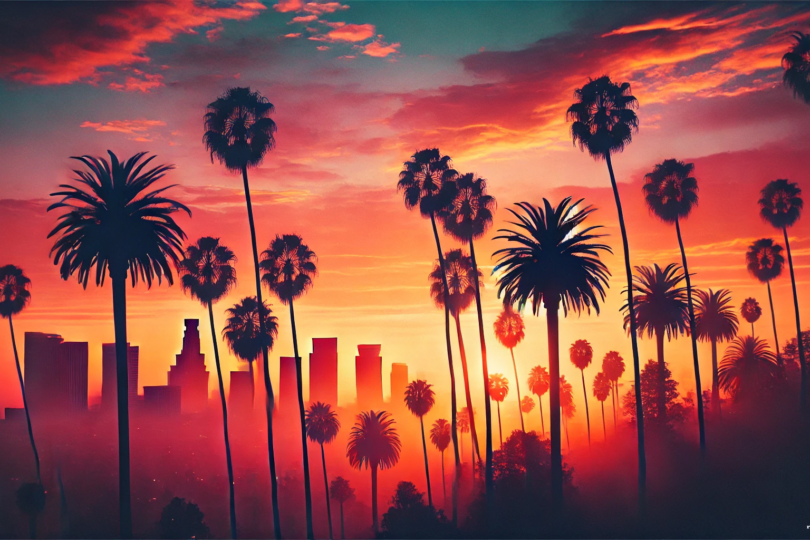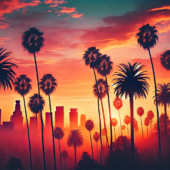Things to do in L.A. / Los Angeles
- Hollywood Walk of Fame: Explore the iconic Walk of Fame, visit Madame Tussauds Hollywood, and see the TCL Chinese Theatre.
- La Brea Tar Pits: Discover prehistoric fossils and learn about Ice Age animals.
- Miracle Mile Museums: Visit the Los Angeles County Museum of Art (LACMA), the Academy Museum of Motion Pictures, and the Petersen Automotive Museum.
- Rodeo Drive: Experience luxury shopping and celebrity-spotting (though sightings are not guaranteed).
- Griffith Observatory: Enjoy panoramic views of Los Angeles and the Hollywood Sign; visit the planetarium (fee applies).
- Hollywood Sign Hike (Mount Hollywood Trail): A 6-mile roundtrip hike to the Hollywood Sign (bring water).
- Grand Central Market: Explore diverse food stalls in Downtown LA’s historic core.
- Bradbury Building: Visit this historic architectural landmark featured in numerous films.
- Angels Flight Railway: A funicular railway offering scenic views of Downtown LA (costs $1).
- Bunker Hill Museums: Explore several museums in the Bunker Hill area, including the Museum of Contemporary Art (MOCA).
- Walt Disney Concert Hall: Attend a performance or admire the architecture.
- Los Angeles Zoo: Enjoy a zoo experience (prices are relatively affordable).
- Autry Museum of the American West: Learn about the history of Los Angeles and the American West.
- Getty Center: Explore art and enjoy stunning city views (free, but reservations are recommended).
- Descanso Gardens: Discover diverse botanical gardens (fee applies).
- Santa Monica Pier: Experience the iconic pier with amusement park rides and ocean views.
- Echo Park: Relax by the lake, rent a swan boat (fee applies).
- Universal Studios Hollywood: Explore the theme park (fee applies; check online for discounts).
- Old Pasadena: Explore this charming area, ideal for a relaxed atmosphere and affordable accommodation.
- Huntington Library, Art Museum, and Botanical Gardens: Visit historic buildings, explore diverse botanical gardens (fee applies).
- Venice Beach: Experience the vibrant beach culture, street performers, and eclectic atmosphere.
- The Grove and The Original Farmers Market: Enjoy upscale shopping and dining at The Grove and fresh produce at the Farmers Market.
- Ventura Harbor: Explore the harbor, enjoy beaches, and consider a drive along the Pacific Coast Highway.
- Hermosa Beach: Relax on the beach, play volleyball, and enjoy the local restaurants.
- Long Beach: Visit the Queen Mary (currently closed), take the Catalina Express to Catalina Island, and explore the Pine Avenue Pier.
- Manhattan Beach, Redondo Beach: Explore these beach towns known for their relaxed atmosphere and beautiful beaches.
- Malibu: Enjoy beaches, hiking, and scenic drives along the Pacific Coast Highway.
- Ranchos Palos Verdes: Explore upscale resorts, hiking trails, and stunning coastal views (more expensive area).
- Transportation: Consider using Amtrak for travel between cities, and explore Los Angeles’ public transportation system.
- Airports: LAX, John Wayne Airport (SNA), Burbank Airport (BUR), and Ontario International Airport (ONT) serve Los Angeles.
- Food: Enjoy diverse culinary options, including Asian fusion, Mexican, and Latin American cuisines.
Must do activities for you to do while visiting Los Angeles! In this Los Angeles travel guide we show you around downtown Los Angeles attractions, Santa Monica, Hollywood, several LA beaches, Pasadena and much more! In this Los Angeles travel vlog you will discover the best places to go in Los Angeles and find useful travel tips for LA.
LA: Good, bad, and ugly documentary.
- Los Angeles’ Complexity: The documentary reveals LA as a sprawling metropolis far exceeding the Hollywood image, encompassing diverse cultures and lifestyles.
- Chicano Culture: It highlights Chicano culture, exploring its unique blend of Mexican and American influences, and its expression through lowrider car culture, particularly on Whittier Boulevard.
- Gang Culture’s Influence: The film connects Chicano culture with gang culture, acknowledging its presence and impact on the community, but also showcasing the community’s resilience and adaptation.
- Immigration and Politics: The impact of immigration policies on the Mexican and Mexican-American communities is discussed, highlighting the fears and challenges faced.
- Venice Beach and Pop Culture: The iconic Venice Beach is presented as a symbol of the “quintessential California” often portrayed in media, contrasting with the city’s less glamorous realities.
- Skid Row’s Struggles: The documentary portrays Skid Row, highlighting the harsh realities of homelessness, substance abuse, and the city’s approach to managing the area.
- Car Culture and Traffic: Los Angeles’ car-centric culture and notorious traffic are presented as a unifying experience for residents.
- Korea Town’s History and Identity: The vibrant Korea Town is explored, showcasing its cultural significance, business landscape, and the challenges faced by Korean immigrants, including the 1992 LA riots.
- Wildfires and Devastation: The impact of recent devastating wildfires in Altadena is depicted, highlighting the loss of homes and the community’s struggle to rebuild.
- Fashion District’s Latino Heritage: The Fashion District’s vibrant Latino culture and its diverse street food scene are showcased.
- Overall Impression: The documentary ultimately suggests that Los Angeles is a multifaceted city with hidden depths, defying simplistic narratives and offering unexpected beauty and resilience.
LA History From Above
Aerial Los Angeles, nineteen sixty-one.
- Geographic Factors Driving Growth: Los Angeles’s location on a plain surrounded by mountains, ocean, and the Los Angeles River provides diverse resources and opportunities, fostering its expansion.
- The Role of the Los Angeles River: Historically the city’s water source, the river continues to supply water and remains a central element in the city’s development. The original city center developed near the river and its railroad terminal.
- Downtown Revitalization: While initially neglected due to sprawl and slow transportation, downtown Los Angeles experienced a resurgence thanks to the freeway system, improving accessibility from surrounding areas.
- Freeway System’s Impact: The construction of freeways dramatically changed Los Angeles’s landscape, connecting previously isolated areas and facilitating rapid growth, although it also created significant traffic challenges.
- Water Management and Future Planning: The city’s proactive approach to securing water resources, such as the Owens River Aqueduct, demonstrates long-term planning for sustained growth and a large population.
- Vertical Growth and Suburban Expansion: Los Angeles’s growth is characterized by both outward expansion into suburbs and upward development of high-rise buildings, particularly in areas like Wilshire.
- Economic Diversity: The city’s economy encompasses agriculture, oil, manufacturing, defense, and a major port, contributing to its overall prosperity and attracting a diverse population.
- Suburban Development and Interdependence: Suburbs like Pasadena, Santa Monica, and others are closely linked to the central district, forming an interconnected metropolitan area reliant on the freeway system for transportation and commerce.
- Variety of Lifestyle Options: Los Angeles offers a wide range of living options, from suburban homes to beachfront properties and mountain retreats, attracting individuals seeking diverse lifestyles and opportunities.
- Rapid Growth and Challenges: The text highlights Los Angeles as the fastest-growing metropolis globally, but also points out resulting challenges like traffic congestion and the need for continued water resource planning.
LA History
Southern California: A 1953 welcome.
- Los Angeles’s Growth and Development: The film highlights Los Angeles’s rapid growth from a small pueblo to a major metropolitan city, emphasizing its architectural landmarks (City Hall), shopping centers (Miracle Mile), and renowned hotels (Ambassador Hotel).
- Hollywood and the Entertainment Industry: The significant role of Hollywood and its studios in Southern California’s economy and tourism is detailed, showcasing iconic locations like Grauman’s Chinese Theatre, Sunset Boulevard, and the studios of major broadcasting companies.
- Tourist Attractions and Recreation: The film extensively promotes various attractions, including Griffith Observatory, Forest Lawn Cemetery, Huntington Library, beaches, sporting events (polo, golf, horse racing), and theme parks (Los Angeles County Fair).
- Higher Education and Cultural Institutions: The University of California, Los Angeles (UCLA) and the University of Southern California (USC) are presented as prominent institutions of higher learning. The Tournament of Roses Parade in Pasadena is also highlighted as a major cultural event.
- Catalina Island and Other Destinations: The film showcases Catalina Island as a popular tourist destination and briefly features other areas like Palm Springs, Laguna Beach, and San Diego, emphasizing their unique charms and recreational opportunities.
- Industrial Growth and Economic Diversity: The film touches upon the significant industrial growth in Southern California, mentioning tire manufacturing, oil production, chemical industries, aircraft manufacturing, and the importance of the railroad system.
- San Diego and Tijuana: The film promotes San Diego, highlighting its zoo, the Coronado Hotel, and its proximity to Tijuana, Mexico, as a cross-border tourist destination.
- Agriculture and Citrus Industry: The importance of the citrus industry to Southern California’s economy is illustrated, featuring the Orange Show in San Bernardino.
- Overall Impression: The film aims to portray Southern California as a land of sunshine, beauty, diverse attractions, economic prosperity, and warm hospitality, emphasizing its appeal to both residents and tourists.
Lost Los Angeles: PBS SoCal documentary.
- The Erasure of Bunker Hill: The narrative centers on the demolition of Bunker Hill in Los Angeles, highlighting the loss of history and memory associated with this urban renewal project. The speaker, a former resident, emphasizes the complete absence of preserved structures from the original Bunker Hill.
- Memory and Place: The speaker argues that severing history from place results in significant loss. The physical spaces, even partially destroyed or contested ones, are crucial in generating and preserving collective memory. The absence of Bunker Hill creates a haunting presence, a void that speaks volumes about the city’s past.
- Angel’s Flight: Angel’s Flight, a former funicular railway serving Bunker Hill, symbolizes the lost connection between the hill and downtown Los Angeles. Its periodic test runs and the crowds eager to ride highlight the enduring public interest in this lost piece of urban history.
- Modernist Urban Planning: The demolition of Bunker Hill is presented as a product of mid-20th-century modernist urban planning, which prioritized functionality and efficiency over historical preservation. This erasure, however, resulted in an irretrievable loss of cultural heritage.
- The Nature of Memory: The speaker reflects on the dynamic and evolving nature of memory, describing it as a process of constant erasure, recovery, and reconfiguration. The city itself is viewed as a “living, selected, and partial memory.”
- Social Impact: The destruction of Bunker Hill impacted the lives of its residents, particularly older people who had established a strong sense of community. The loss of gathering places like Pershing Square and a former “Speakers Corner” is emphasized.
History of Los Angeles
🌄 Pre-Colonial Era (Before 1769)
The Tongva (also known as the Gabrielino) were the original inhabitants of the Los Angeles Basin for thousands of years. Their sophisticated society had villages, trade networks, and spiritual practices tied to the land.
🇪🇸 Spanish Colonial Period (1769–1821)
In 1769, Spanish explorer Gaspar de Portolá and missionary Junípero Serra established the first European presence. In 1781, the town “El Pueblo de Nuestra Señora la Reina de los Ángeles de Porciúncula” (The Town of Our Lady the Queen of Angels of Porciúncula) was officially founded by 44 settlers. Missions and ranchos were established, reshaping land ownership and Native life.
🇲🇽 Mexican Era (1821–1848)
Mexico gained independence from Spain in 1821, and Los Angeles became part of Mexican Alta California. Land grants created a rancho economy focused on cattle ranching. Los Angeles remained a small, dusty pueblo but was growing steadily.
🇺🇸 American Annexation & Early Statehood (1848–1880)
After the Mexican-American War, California became U.S. territory under the Treaty of Guadalupe Hidalgo in 1848. In 1850, California became a state, and Los Angeles was incorporated as a city. Lawlessness and frontier justice marked early American-era LA.
🚂 Railroads & Growth (1880s–1910)
Arrival of railroads in the 1870s and 1880s turned LA into a boomtown. Aggressive marketing brought settlers from the Midwest and East. Orange groves and sunny weather were key selling points.
💧 Water & the Owens Valley (1905–1928)
The Los Angeles Aqueduct, built by William Mulholland, brought water from the Owens Valley in 1913. This enabled explosive growth but also sparked conflict (e.g., the California Water Wars).
🎬 Hollywood Rises (1910s–1930s)
By the 1910s, film studios moved west to escape patent laws and take advantage of the weather. Hollywood quickly became the heart of the global film industry. LA’s identity became tied to movies, glamour, and celebrity.
🏙️ Modernization & Suburbanization (1940s–1960s)
WWII brought a boom in manufacturing and aerospace industries. Post-war freeway construction turned LA into a car-centric, sprawling metropolis. Suburbs expanded rapidly, often with racial and economic segregation.
⚖️ Civil Rights, Riots & Activism (1960s–1990s)
Racial tensions flared due to systemic inequalities. Major events: Watts Riots (1965), Rodney King beating & LA Riots (1992). LA became a focal point for conversations around race, policing, and justice.
🌐 21st Century LA (2000s–Today)
One of the most diverse cities in the world, with over 180 languages spoken. Tech, entertainment, and creative industries continue to drive the economy. Gentrification, homelessness, housing affordability, and climate adaptation are key challenges. A global city and cultural capital with deep local roots.
LA Housing
Los Angeles housing scandal revealed.
- Los Angeles Housing Department (LAHD) is harming landlords: The LAHD’s actions are described as “robbing and raping landlords,” prioritizing tenant rights to the detriment of property owners. The show presents several anecdotes of landlords facing financial ruin and health problems due to lengthy legal battles with tenants supported by the LAHD.
- LAHD’s Tactics Delay Evictions: LAHD regulations require a minimum rent owed exceeding the fair market value before a three-day notice can be served. This forces landlords to wait an additional month, impacting their ability to pay mortgages, taxes, and LAHD fees. Furthermore, minor violations of the Los Angeles Rent Stabilization Ordinance (RSO) provide a complete defense against unlawful detainer actions, even if the notice wasn’t reviewed by the LAHD.
- LAHD’s Procedures are Burdensome and Seemingly Pointless: Landlords are required to upload eviction notices to the LAHD, but these notices are not reviewed. This seemingly serves only to provide tenant attorneys with grounds to challenge evictions. Similar requirements exist for posting tenant-protection notices, which tenants often remove.
- LAHD’s Actions Create Unnecessary Financial Burdens: Landlords must pay yearly interest on security deposits, even if the amount is minimal. Failure to do so is a complete defense in an unlawful detainer action.
- LAHD’s Mismanagement and Budget Concerns: The LAHD has faced a $38.2 million settlement with the federal government due to mismanagement and poor financial accountability. Despite a $1 billion budget deficit, the city council approved “right to counsel” for low-income tenants in eviction cases, further burdening the city’s finances.
- Specific Legal Questions Addressed: The show answers numerous questions about rent increases (30-day vs. 90-day notices under AB1482), lease survival after foreclosure, tenant access to properties, JSO registration requirements, e-bike restrictions, rent gouging laws, security deposit refund forms, commercial leases, and reporting positive rental payments to credit bureaus.
Avoid Los Angeles’s tourist traps.
- Don’t underestimate the traffic: Los Angeles traffic is constant and severe; plan extra travel time (consider 3x estimated time), especially during peak hours. Surge pricing for ride-sharing services will be significantly higher during these times.
- Downtown LA isn’t a major tourist hub: While it exists, Downtown LA lacks the concentration of major attractions found in other areas like Hollywood, Beverly Hills, Santa Monica, and Venice Beach. Unless using public transport, it’s generally less convenient for tourists.
- Be cautious around homeless individuals: Los Angeles has a significant homeless population. While most won’t bother you, avoid interacting with those in encampments or exhibiting erratic behavior.
- Limit reliance on public transportation: Public transportation is not comprehensive and may not be efficient for navigating many tourist destinations. Renting a car, using ride-sharing services, or extensive planning with the metro is recommended.
- Don’t expect to see celebrities: While Los Angeles is home to Hollywood, sightings of famous people are infrequent. Studio tours offer a better chance of encountering celebrities.
- Tip street performers: Street performers and buskers are common. If you take photos, be prepared to tip them; failure to do so may result in harassment.
- The ocean water is cold: The Pacific Ocean off the coast of Los Angeles is cold; consider a wetsuit for water activities.
- Utilize the LA Times 101 Restaurants list: This list provides a diverse range of dining options, from high-end to food trucks.
- Plan your driving routes: Avoid aimless driving; use GPS and stick to planned routes, as some neighborhoods are unsafe. Expect expensive parking.
- Never drive on the freeway shoulder: This is extremely dangerous and illegal.
- Refer to freeways by their numbers, not “I-“: Locals refer to freeways using only the numbers (e.g., “the 405,” not “I-405”).
- Don’t try to drive to the Hollywood Sign: It’s inaccessible by car; view it from designated viewpoints.
- Manage expectations for celebrity home tours: These tours may not always show the current residences of celebrities, and the experience might be less exciting than anticipated.
- Expect lateness from locals: Due to traffic and the general acceptance of lateness, don’t be surprised if locals arrive late for meetings.
- Smoking is frowned upon: Smoking and vaping are discouraged in many public areas.
- Explore the museums: Los Angeles has a wealth of museums, including the Getty Center, LACMA, and The Broad.
- Visit theme parks: Universal Studios Hollywood and Disneyland are major attractions.
- Rodeo Drive is smaller than you might think: It’s only three blocks long.
- Embrace the grit and grime of Hollywood: Hollywood is not always glamorous; manage your expectations.
- Some attractions may appear run-down: Many famous sites may not be as pristine as expected.



